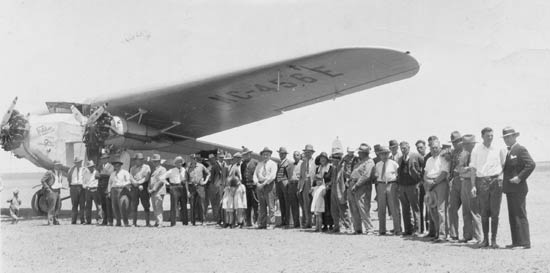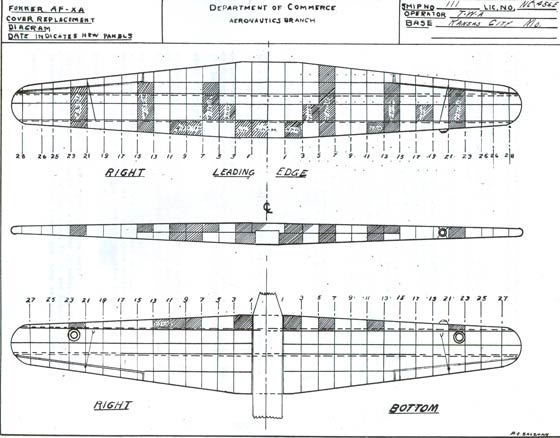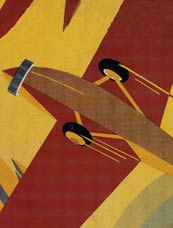|
This big, trimotor airplane landed once at Tucson on June 19, 1930 at 6:25PM. It was flown by Hap Russell carrying six unidentified passengers. They arrived at Tucson from Los Angeles, CA, remained overnight, and departed for El Paso, TX the next morning at 7:45AM. Russell noted "Airline" in the Remarks column of the Register. According to the FAA record, as of the date of this flight NC456E was owned by Western Air Express, Inc.
Interestingly, Russell had been Chief Pilot for Standard Air Lines (PDF 670kB). When Standard merged with Western Air Express (WAE), he worked for that company (his landing with NC456E was during that time). He then went to work for American Airways and then, after another exhilirating corporate merging and readjustment, American Airlines. He remained with American for 35 years as employee number 11, having kept his seniority ranking from his Standard Air Lines and WAE days. Please direct your browser to his link for lots of additional information and pictures.
Below is a photograph of NC456E taken at Holbrook, AZ in 1929. This image comes to us courtesy of the Navajo County Historical Society. All the people were not passengers on this flight, but their numbers are indicative of what a big deal it was to have an airplane of this size on the ground in the area.
Fokker NC456E, Holbrook, AZ 1929
 |
Also of interest, we have the names of some of the people. Why should we care who these people are? Because search engines will crawl this page soon after it's online, and every name will then be searchable by their relatives who are googling their grandfathers and grandmothers.Thus, the people are, L to R (front row only; children excluded): Shorty Thomas, Charlie Cooley, UNK, UNK, T.J. Koury (short man in the white shirt), Frank Baumback, Dan Divelbess (sideways; suit), Bill Hookway, Frank Felsch, UNK, Tom Jordan, John Kist (white shirt), Judge Jesse Crosby (vest), Frank Minnie, Frank O'Connell, Emma O'Connell (?), Judge W.D. Easley (under tail), George Schaffer, Columbus Giragi (white shirt), W. Dean Nutting (dark jacket), UNK, pilot (?) J.M. Sheppard, Mr. Lockley.
The FAA was good enough to share with us the entire historic record for NC456E, including the chain of custody from manufacturer to final owner. The airplane was serial number 1019, certified under Type Certificate #96. It was manufactured ca. March, 1928 by the Fokker Aircraft Corp. of America, Glendale, WV. It was a large airplane with wingspan 79'2", length 49'11", and an empty weight of 8,462 lbs.and gross weight of 13,100 lbs. It had a seating capacity of 12 persons, plus the pilot and copilot.
NC456E left the factory with three Pratt & Whitney Wasp engines of 410HP each (S/Ns 1104, 1106 & 1105). Each had a 3-blade adjustable pitch propeller. The original buyer, on February 26, 1929, was Western Air Express, Inc., Los Angeles, CA. It was furnished with basic equipment: tachometer, altimeter, compass, oil temperature gauge, fuel gauge, turn & bank indicator, airspeed indicator, oil pressure gauge, ammeter, voltmeter, 8-day Waltham clock, first aid kit, fire extinguisher and seat belts.
WAE applied for a radio license for the airplane on February 7, 1930. On that date a Western Electric vacuum tube model 8-A was installed. It was a 6-tube, 50-watt unit, transmitting and receiving on 6350, 3460 and 3070 kc. Its call sign was KHCHS.
On March 24, 1931, coincident with WAE merging with Transcontinental & Western Air, Inc. (TWA), the airplane changed hands from WAE to TWA. On April 11, 1931, a letter went out to the local Department of Commerce (DOC) aeronautical inspector to pay particular attention to the possiblility of aileron or wing flutter on the airplane. This appears to have been a hushed event, as the incidence of flutter could denote a design flaw across the fleet. The feds did not want to start rumors.
Site visitor Roger Holden remarks, "... the wing inspection regime and addition of the aileron balances was in response to the investigation resulting from the TWA F-10A crash which infamously killed the football coach, Knute Rockne, probably the most famous airliner disaster of the period. These measures were mandated for all F-10As and the aileron balances appear on all planes circa 1932. Although it was never conclusively proven that wing flutter was responsible, that was blamed and was effectively the death knell for Fokker airliners in the U.S. Probably a harsh judgement as they continued to operate successfully with European airlines until WW2." A discussion of the Rockne accident is at the link.
Although the aircraft inspection paperwork for NC456E of August 22, 1931 stated nothing about wing or aileron flutter, a detailed list of work accomplished on the airplane during that inspection stated, "Installed one new F-10-A wing, including landing lights, box type ailerons, aileron balance weights (aileron hinges bolted to wing and aileron), and TWA signal light.... Wing finished in aluminum varnish. Two additional coats of Inter-National orange applied to top half of wing." The aileron balance weights suggest there was a problem with flutter. Note the color information and compare it to that at the link describing the colors of other Fokker aircraft.
Upon inspection on February 23, 1932, the total flight time on the airplane was 3,023 hours and 23 minutes in the four years since its manufacture. If you do the math, that's slightly over 750 flight hours per year, a good amount of time for a working airplane of the era. That inspection yielded from the inspector a list of what mechanics today call "squawks." He stated, "The general condition of the wing is entirely satisfactory [remember, it had been replaced barely five months earlier]. However, thirty-eight panels were removed and all scarf joints in the wing inspected. The following repairs were specified as a result of this inspection."
The list of fifteen squawks was complied with on April 30, 1932 at TWA's repair facility in Kansas City, MO according to the following hand-drawn diagram from the FAA record. The wing internal structure was made of wood. The exterior panels were also made of thin wood. The dark areas in the diagram indicate the repaired wood panels on the wing surface.
Wing Repairs, NC456E, April 30, 1932 (Source: FAA)
 |
This was a big job, and that was not all. The inspector requested that TWA, "... remove all finish down to the panels along the entire leading edge, and build up a complete new finish, the balance of the wing to be repainted." And further, "...that the operator install gussets on all ribs not gusseted and replace all cracked or otherwise damaged stringers."
Finally, on June 4, 1932, a letter was received by TWA from the Chief of the Engineering Section, DOC, stating that, "A satisfactory inspection report pertaining to repairs to the subject airplane has been received by this office. The airplane is now eligible for relicense in so far as these repairs are concerned." This was about four months of non-revenue time for the airplane while it was undergoing repairs.
As of September 7, 1932, about two months after the repairs, NC456E was reported to have accumulated 3,693 flight hours. That's about 670 total flight hours since repairs; over 220 hours per month. Compare that to the 750 hours PER YEAR it was flown before repairs.
This cycle of wing inspections approximately every 400 hours seems to have paid off. A December 19, 1932 letter to the DOC from the local inspector gave NC456E's wing a clean bill of health as follows, "The general condition of this wing is excellent. Apparently, keeping the finish on the wing in good condition does a great deal toward keeping the plywood up and not brittle. There were no panels which were weathered."
On March 11, 1933, the airplane had accumulated 4,308 hours and 14 minutes of flight time. It was based in Los Angeles at Grand Central Air Terminal, flying passenger service between there and San Francisco, CA. As far as can be determined from the record, it did this for about the next two years.
On January 14, 1935, NC456E was, "Sold. To a new corporation of same name." This was an internal shift of assets, which, according to the FAA record, was mirrored by a new set of TWA corporate officers and members of the Board of Directors. Not surprisingly, the new Chairman of the Board was Register pilot Henry B. duPont. Register pilots Jack Frye and Paul Richter were president and vice president, repectively.
About seven months later, on July 12, 1935, NC456E and another TWA liner, NC583K (not a Register airplane), were sold to Register pilot and aircraft broker Charles H. Babb of Glendale, CA. On July 31, 1935, a letter to the DOC from Warner Bros. Pictures, Inc. informed them that they had purchased NC456E from Babb, and, "We do not ever intend to use this ship for Flight purposes and do not care to have it registered."
Indeed, on August 5, 1935, Babb informed the DOC in a letter that he had sold 456E, "... to a motion picture studio and is to be wrecked and is never to be used for flying purposes again." The bill of sale completing this transaction was signed on August 26, 1935. Does anyone KNOW how or when, or in what movie this proud and historic airliner met its final fate? A site visitor on 6/20/11 states that 583K appears briefly in the 1935 Charlie Chan Movie "Charlie Chan in Paris." NC583K must have been sold to 20th Century Fox.
---o0o---
Dossier 3.1.42
THIS PAGE UPLOADED: 12/22/07 REVISED: 02/09/10, 06/20/11
|



